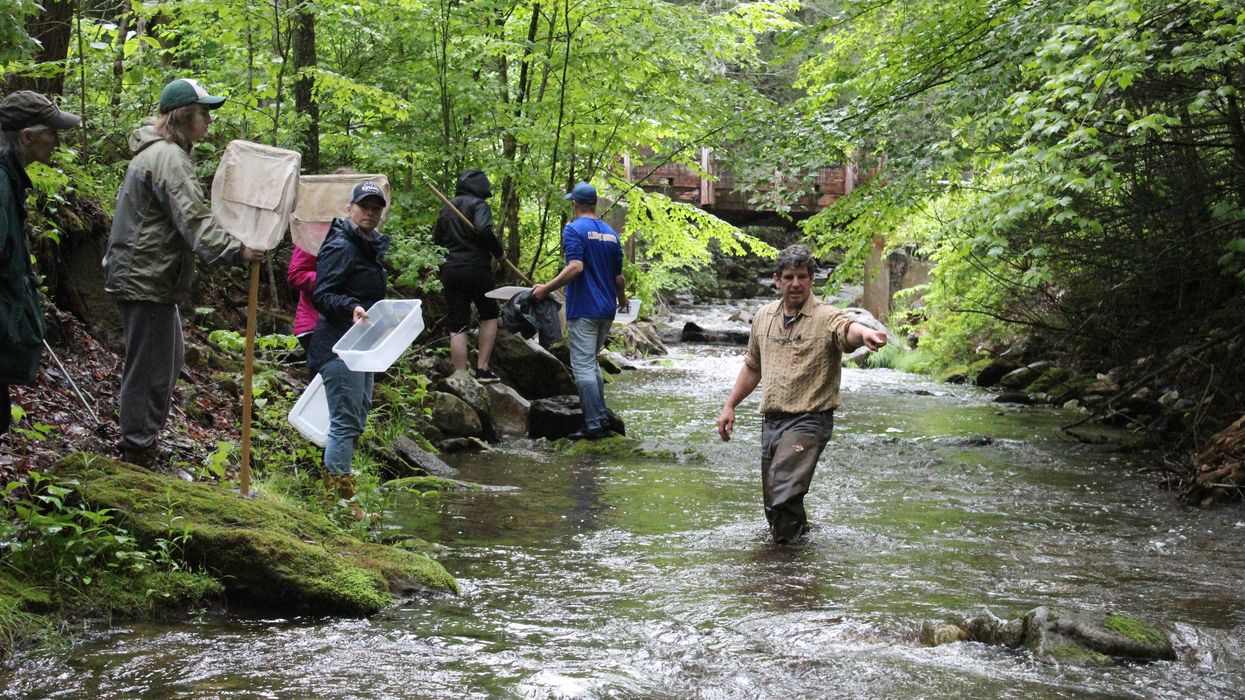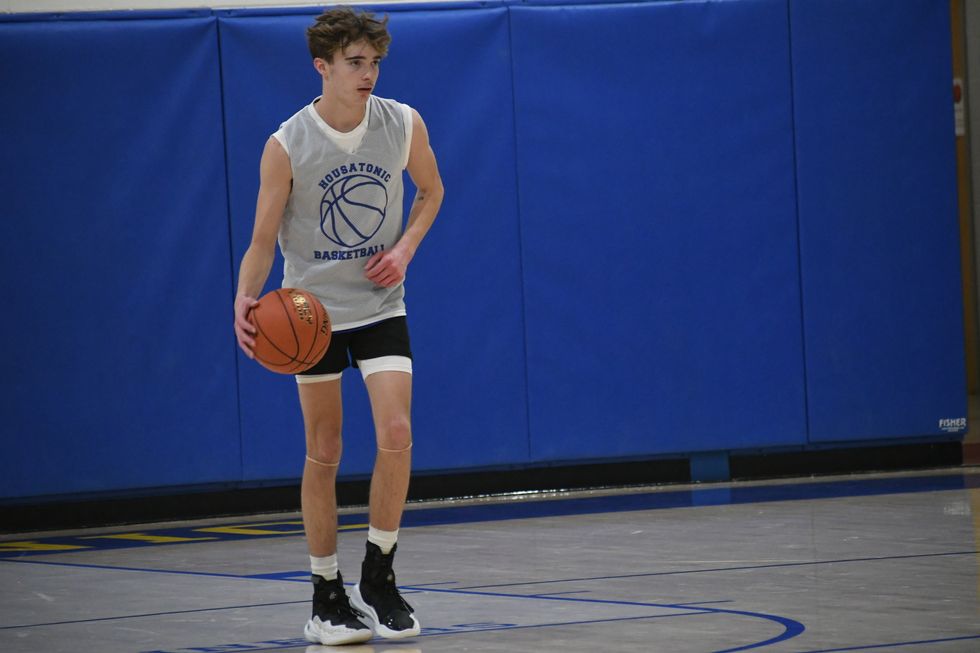GMF leads bug count to determine stream health

Tom Fahsbender, right, directs stream testers in Great Mountain Forest May 31.
Patrick L. Sullivan

Tom Fahsbender, right, directs stream testers in Great Mountain Forest May 31.
FALLS VILLAGE — One way to determine if a stream has trout in it is to fish it, either with rod and reel, or by electrofishing, in which a section is zapped with electricity and stunned fish float to the surface, where they can be quickly cataloged before they get their wits back and swim away.
The other way is to look at the local environment. Trout need cold, clear, oxygenated water, and they need bugs to eat. If these conditions are met, then the habitat probably supports trout.
This was the plan along Wangum Brook in Great Mountain Forest on the Falls Village side on Saturday, May 31.
Educator Tom Fahsbender met at the GMF barn on Canaan Mountain Road with a group of adults and high school students for a quick briefing at 9 a.m.
He explained that he had performed the same survey in the same spot about 10 years ago with a different group of volunteers.
The work is part of a state Department of Energy and Environmental Protection program called Riffle Bioassessment by Volunteers.
The surveys, conducted by similar groups of volunteers statewide, look for streams and rivers with no known pollution sensitivities, a year-round flow, plenty of riffles, no dams, and relatively shallow so the volunteers can get in and out without too much trouble.
Fahsbender said he will submit the information gathered by the group to DEEP, which will include it in the next update of the health of the state’s streams.
Of particular interest were macroinvertebrates, such as may flies, caddis flies, stone flies and dobson flies — also known as hellgrammites.
Fahsbender said the presence of these insects is used as “a proxy for water quality.”
“If it’s too warm or polluted or not oxygenated, these organisms won’t live there.”
“You don’t have to be a scientist,” he emphasized.
“It all comes from fly-fishing,” he added. Fly anglers know about the different insects that make up a trout’s diet, and use artificial imitations of real bugs to catch trout.
The surveys must be done the same way, with the same equipment. Fahsbender brandished a kick net with a rectangular business end of 18 x 14 inches and a fine mesh net.
As a bonus, the handle end serves as a wading staff as the volunteer enters the often slippery stream.
The procedure went like this.Each team — there were two teams of two people and one team of three on this occasion — selected a riffle and two areas within the riffle to sample.
Prior to entering the stream each team got about an inch of water into a smallish plastic storage bin and stashed it securely along the bank.
Once in the stream, one person held the net steady in the flow while the other spent two minutes just upstream of the net, picking up rocks and scrubbing them with their hands.

Fahsbender said this is necessary to dislodge the insects, which often cling quite stubbornly to the rocks.The sampler spent a minute stirring the streambed with a foot to dislodge anything that might have escaped the first procedure.
Then the gunk in the net was carefully emptied into the storage bin.
Just to make everything more exciting, it rained off and on during the collection period. And young Jackson Davis lost the felt sole from one of his hip boots.
The somewhat soggy crew then drove back up the hill to the GMF barn to examine their samples.
As expected, this involved a lot of separating stream matter — leaves, moss — and bugs. Sometimes a bug was lurking in the stream matter.
Bugs were then transferred into ice cube trays with a bit of water to keep them happy.
Kurt and Jonas Johnson from North Canaan — and Housatonic Valley Regional High School — found a prize: a cased caddis fly.
“It was coming out when we found it but it went back in” observed Jonas.
Jackson Davis, his mother Barb, and Julia Reinert nabbed a stonefly. The Davises are from Canton and Reinert from Winsted. The teens, along with a member of team number three, Cali Hoehne of Torrington, are in the agriculture education program at Northwestern Regional High School.
Cali’s mother Keri rounded out the third team. She displayed considerable rock-scrubbing skills.
Fahsbender scooted around the room, keeping an eye on things and reacting to the occasional cries of triumph. It was a pleasant scene.
For more information on the RBV program, see portal.ct.gov/deep/water/inland-water-monitoring/riffle-bioassessment-by-volunteers-rbv
The Salisbury Winter Sports Association (SWSA) will host its annual Junior Jump Camp, a two-day introduction to ski jumping, on Saturday and Sunday, Dec. 27 and 28, from 9 a.m. to 2 p.m. at Satre Hill in Salisbury.
The camp is open to children ages 7 and up and focuses on teaching the basics of ski jumping, with an emphasis on safety, balance and control, using SWSA’s smallest hill. No prior experience is required.
The cost is $50 per child and includes instruction and lunch on both days. For more information or to register, visit www.skireg.com/swsa-camp or email info@jumpfest.org
Jesse Bunce, first selectman of North Canaan.
LITCHFIELD — The Northwest Hills Council of Governments welcomed six newly elected municipal leaders Thursday, Dec. 11, at its first meeting following the 2025 municipal elections.
The council — a regional planning body representing 21 towns in northwest Connecticut — coordinates transportation, emergency planning, housing, economic development and other shared municipal services.
Barkhamsted First Selectman Meaghan Cook, Goshen First Selectman Seth Breakell, Kent First Selectman Eric Epstein, Norfolk First Selectman Henry Tirrell, North Canaan First Selectman Jesse Bunce and Torrington Mayor Molly Spino were each elected to their post in November.
They filled the seats of their predecessors on the COG, who were each given a toast of appreciation: Nick Lukiwsky (Barkhamsted), Todd Carusillo (Goshen), Marty Lindenmeyer (Kent), Matt Riiska (Norfolk), Brian Ohler (North Canaan) and Elinor Carbone (Torrington).
COG Executive Director Rob Phillips said the outgoing members were given a going away mug that read “You’re living the dream still.” Members voted to appoint Warren First Selectman Greg LaCava to fill a vacancy on the Council’s Executive Committee. COG members voted by paper ballot, and LaCava defeated Burlington First Selectman Doug Thompson for the vacant seat.
Ryan Segalla takes a fadeaway shot over a defender.
FALLS VILLAGE — Housatonic Valley Regional High School’s boys basketball team defeated Pine Plains High School 60-22 in a scrimmage Tuesday, Dec. 9. The non-league preseason game gave both sides an opportunity to run the court ahead of the 2025-26 varsity season.
HVRHS’s senior-heavy roster played with power and poise. The boys pulled ahead early and kept their foot on the gas through to the end.
By halftime the score was 33-8. Junior varsity players subbed in for the second half, but not before the starters got some in-game dunk practice. By the end Housatonic totaled 60 points to Pine Plains’ 22.

Nick Crodelle led the Mountaineers offensively with 13 points. Anthony Labbadia and Wyatt Bayer scored nine points each. Anthony Foley scored eight points. Owen Riemer and Ryan Segalla each scored seven points. Peyton Bushnell hit a three-pointer. Jaxon Visockis and Henry Berry each scored two points.
HVRHS begins Berkshire League competition on the road at Nonnewaug High School Tuesday, Dec. 16, with a 6 p.m. tip off.


Katie Moore delivers toys to the Stuff a Truck campaign held by the Kent Volunteer Fire Department last weekend. Donated toys are collected so that parents, who need some assistance, may provide their children with gifts this Christmas. Accepting the donation are elves Fran Goodsell and Karen Iannucci
KENT — Santa’s elves were toasty warm as they collected toys for the children of Kent.
Keeping with annual tradition, Fran Goodsell and Karen Iannucci manned the Stuff a Truck campaign sponsored by the Kent Volunteer Fire Department on Saturday, Dec. 6, and Sunday, Dec. 7. Sitting in front of a fire pit in the firehouse parking lot between donations from residents, they spoke of the incredible generosity displayed every season. That spirit of giving was clear from the piles of toys heaped on a table.
“This is always so gratifying,” said Goodsell, noting that certain businesses, including High Watch Recovery Center, Wilson’s, and Kent and South Kent schools needed a “shout out” for all they’ve done. She said South Kent School focuses on gifts for older children, which is a group that often is overlooked.
Unwrapped contributions are sought for children 1 to 15 years old who might otherwise find little or nothing from Santa, they said. The bounty will be set up at the Community House on Thursday, allowing parents to come and take what they want. If there are still items left, grandparents are invited to “shop.”
The atmosphere was festive Saturday, as a stuffed dog began barking a Christmas tune whenever someone walked in front of it. A large decked-out bear posted at the parking lot entrance reminded passersby of the event. Visiting children were able to get a close-up look at the fire truck and walk through the firehouse if they wished.
Goodsell and Iannucci were very grateful to those who donated wood for the fire pit. “And so many asked if they could bring us coffee or hot chocolate,” said Iannucci.
Goodsell said many who came talked about having grown children who were recipients of the gifts when their families were struggling. “They are so glad to be able to give back,” she said.